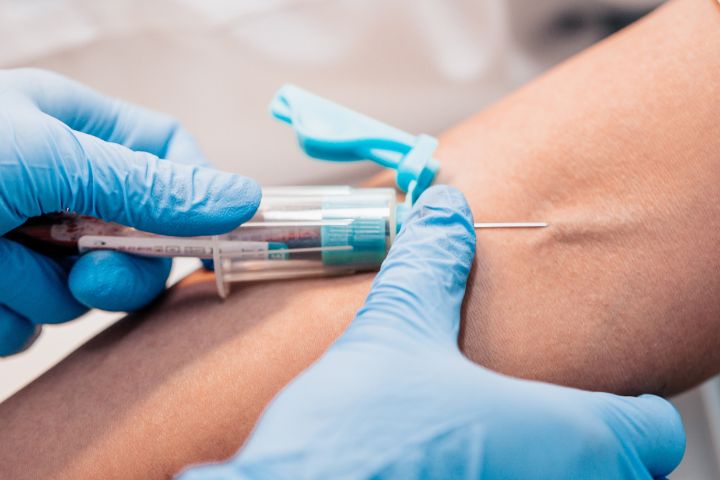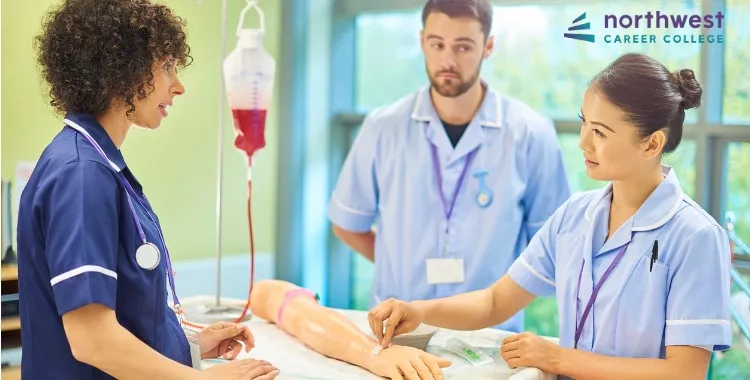Phlebotomy school: What Comes Next
Phlebotomy school: What Comes Next
Blog Article
Exploring the Necessary Abilities Gained From a Phlebotomy Training Training Course for Aspiring Professionals
In a phlebotomy training program, you'll obtain essential abilities that exceed just drawing blood. You'll understand venipuncture strategies and discover the significance of safety protocols. You'll additionally establish the ability to communicate effectively with clients, which can ease their anxiousness. But there's even more to it-- comprehending composition and managing research laboratory devices are just the beginning. What various other crucial abilities can you anticipate to get as you get ready for a profession in this field?
Comprehending Venipuncture Strategies
Grasping venipuncture strategies is necessary for anyone seeking a profession in phlebotomy. You'll require to develop a strong understanding of how to situate capillaries efficiently. Start by exercising palpation skills to feel for the ideal places, commonly in the antecubital fossa - Phlebotomy school. It's all concerning being positive and gentle while dealing with individuals.
You need to acquaint on your own with the numerous needle dimensions and kinds, as choosing the right one can make a difference comfortably and effectiveness. During the procedure, you'll discover to cleanse the website effectively to decrease infection threats.
Exercising the real draw will certainly aid you understand the significance of angling the needle properly to access the capillary without creating unneeded pain. By fine-tuning these skills, you'll not only acquire the depend on of your individuals yet also ensure successful blood attracts, making you a competent phlebotomist prepared for the demands of the task.
Grasping Security Procedures
As you ideal your venipuncture methods, it's just as important to prioritize security procedures to safeguard both yourself and your patients. Acquaint yourself with infection control measures, like correct hand health and using individual safety devices (PPE) Always put on handwear covers when managing blood samples, and change them in between individuals to reduce contamination risk.
You need to likewise recognize exactly how to deal with and deal with sharps securely. Use designated sharps containers and adhere to local standards for biohazard waste disposal. Recognizing these procedures not just keeps you safe however also guarantees your patients.
In addition, stay upgraded on emergency treatments, like what to do in case of a needle stick injury or a negative reaction (Phlebotomy Training Course). Regular training and refreshers on safety and security protocols will boost your confidence and guarantee you're always prepared. By understanding these security actions, you add to a more secure healthcare atmosphere for every person involved
Establishing Person Interaction Abilities
In phlebotomy, constructing rapport with individuals is essential for a favorable experience. You'll need efficient interaction strategies to help relieve their worries and take care of any anxiousness they might feel. By concentrating on these skills, you can develop an extra comfortable environment for both you and your clients.
Structure Relationship With Clients
Building rapport with clients is necessary for reliable phlebotomy technique. When you create a connection, clients feel a lot more comfy and at convenience throughout treatments. Start by greeting them warmly, making eye contact, and using their name. Show authentic rate of interest in their health and pay attention proactively to their issues. This technique assists to alleviate anxiety and builds count on. Keep in mind, your body movement plays a vital role; keep an open stance and smile to reinforce your friendliness. Share a brief, guaranteeing description of the procedure to help demystify the procedure. By focusing on connection, you not only enhance the patient experience yet additionally enhance the accuracy of your work, ensuring that they're relaxed and participating during blood draws.
Reliable Interaction Techniques
Reliable communication strategies are necessary in phlebotomy, because they aid you link with patients and ensure a smoother experience. To develop your individual interaction abilities, focus on making use of clear and concise language. Constantly introduce on your own and describe your function, making certain people really feel comfortable and notified. Proactively listen to their problems and questions, as this reveals you value their input.
Be understanding and patient, especially with those who might be distressed concerning the treatment. Exercising these strategies will certainly boost your capacity to involve with patients effectively and create a positive atmosphere during their gos to.
Managing Client Anxiety
While it's natural for clients to feel anxious about blood attracts, you can play an important role in easing their fears. Start by welcoming them comfortably, making eye get in touch with, and utilizing a calm tone. Explain the treatment plainly and guarantee them that it's quick and routine. Encourage inquiries, and pay attention actively to their concerns-- this shows you care. You can additionally supply disturbances, like discussing light topics or offering a tension round to press. Showing empathy can make a significant difference; recognize their sensations and verify their experience. Warranty they're comfy and sustained throughout the procedure, as a favorable communication can substantially lower their anxiousness and foster depend on in your skills as a phlebotomist.
Understanding Composition and Physiology
Recognizing anatomy and physiology is crucial for grasping phlebotomy skills, as it helps you understand the body's framework and features. You'll find out about the circulatory system, including capillary, arteries, and blood vessels, which is vital for finding blood vessels throughout blood draws. Familiarizing yourself with the different kinds of blood cells and their roles will improve your capacity to explain procedures to clients and comprehend examination outcomes.
Furthermore, comprehending the value of various anatomical landmarks will make you much more effective in determining the most effective sites for venipuncture. You'll additionally explore how the body replies to injury and the healing procedure, which can educate your practice.
Taking Care Of Lab Devices
Taking care of research laboratory tools is important for guaranteeing precise results and a safe workplace. You need to remain on top of upkeep strategies and comply with security procedures to stop accidents. By prioritizing these practices, you'll enhance your performance as a phlebotomist and shield both on your own and your people.
Tools Upkeep Methods
Proper upkeep of laboratory tools is vital for assuring precise examination results and the safety and security of both individuals and staff. Calibrate your tools according to the producer's standards to maintain accuracy. By creating a routine for devices treatment, you'll improve integrity and efficiency read in your research laboratory practices.
Safety And Security Protocols in Labs
While it is critical to maintain lab tools, adhering to security methods is similarly vital to safeguard everybody in the laboratory. Constantly put on appropriate personal protective devices (PPE), like handwear covers and safety glasses, to minimize exposure to dangerous materials. Acquaint on your own with the area of safety and security tools, such as eyewash stations and fire extinguishers, ensuring they're available. Appropriately tag and shop all chemicals to protect against accidents and mix-ups. When using sharp instruments, handle them thoroughly and throw away them in marked containers. Maintain your work space arranged to lower the threat of spills or injuries. Routinely examine devices for any type of indications of wear or malfunction, and report problems right away. By complying with these procedures, you contribute to a safer environment for everyone involved.
Carrying Out Quality Control Actions
Applying top quality control steps is vital for ensuring the precision and dependability of phlebotomy methods. You need to frequently calibrate and keep your equipment, as also small discrepancies can lead to substantial errors in results.
You must additionally get involved in recurring training to stay updated on the newest methods and modern technologies in the area. By focusing on top quality control, you not just enhance your own skills yet also contribute to much better individual end results and the total integrity of the health care system.
Browsing Lawful and Ethical Factors To Consider
You'll require to acquaint yourself with legislations concerning patient permission, privacy, and handling of biological products. Constantly make certain you have informed permission from clients prior to executing any kind of procedures.
Ethically, you ought to appreciate patient personal privacy and keep confidentiality in all times. Recognize the Wellness Insurance Transportability and Liability Act (HIPAA) guidelines, which i loved this govern the handling of sensitive wellness info.
Additionally, remain updated on your facility's plans and treatments to ensure conformity with local legislations and standards. When unsure, consult your supervisor or lawful resources - Phlebotomy school. By focusing on these legal and moral aspects, you'll promote a secure environment for clients and promote the integrity of your occupation
Often Asked Inquiries
What Career Opportunities Are Offered After Finishing Phlebotomy Educating?
After finishing phlebotomy training, you can pursue profession possibilities as a phlebotomist in medical facilities, centers, blood contribution facilities, or laboratories. You might likewise take into consideration roles in research study or clinical aiding, expanding your professional perspectives.
For how long Does a Common Phlebotomy Training Program Last?

Is Qualification Called For to Function as a Phlebotomist?
Yes, accreditation is frequently required to work as a phlebotomist. It shows your skills and knowledge, making you a lot more competitive in the work market. Employers typically like licensed candidates for these placements.
What Are the Expenses Associated With Phlebotomy Training Programs?
Phlebotomy training programs commonly set you back in between $700 to $3,000, depending upon the institution and location. You'll likewise need to allocate textbooks, products, and accreditation site link exam charges, which can include to your total costs.
Can Phlebotomy Educating Be Completed Online?

Report this page